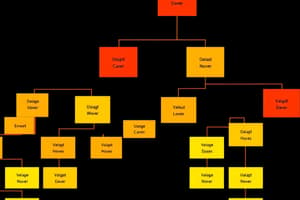Podcast
Questions and Answers
What metric evaluates the percentage of correctly predicted positive instances among all predicted positives?
What metric evaluates the percentage of correctly predicted positive instances among all predicted positives?
- Accuracy
- Specificity
- Recall
- Precision (correct)
Which metric is specifically used to assess the homogeneity of data within a node in decision tree algorithms?
Which metric is specifically used to assess the homogeneity of data within a node in decision tree algorithms?
- Gini impurity (correct)
- AUC
- F1-score
- Accuracy
What is the F1-score primarily used for in the evaluation of models?
What is the F1-score primarily used for in the evaluation of models?
- Combining precision and recall into a single metric (correct)
- Determining the number of positive instances
- Evaluating overall model performance
- Measuring accuracy of predictions
Which metric indicates a model's ability to distinguish between positive and negative classes?
Which metric indicates a model's ability to distinguish between positive and negative classes?
What does specificity measure in a classification model?
What does specificity measure in a classification model?
Which decision tree algorithm is specifically designed for both classification and regression tasks?
Which decision tree algorithm is specifically designed for both classification and regression tasks?
What does CART primarily aim to maximize within each subset after the data is split?
What does CART primarily aim to maximize within each subset after the data is split?
Which algorithm is not suitable for datasets with continuous variables?
Which algorithm is not suitable for datasets with continuous variables?
What is a notable feature of the C5.0 algorithm compared to C4.5?
What is a notable feature of the C5.0 algorithm compared to C4.5?
Which decision tree algorithm uses gain ratio to better select the best split at a node?
Which decision tree algorithm uses gain ratio to better select the best split at a node?
Which algorithm employs statistical inference to construct decision trees?
Which algorithm employs statistical inference to construct decision trees?
What is the purpose of using Gini impurity or entropy in CART?
What is the purpose of using Gini impurity or entropy in CART?
What characteristic distinguishes QUEST from other decision tree algorithms?
What characteristic distinguishes QUEST from other decision tree algorithms?
Flashcards
Accuracy
Accuracy
The percentage of data points that were correctly categorized by the model. A higher accuracy means the model is more accurate overall.
Precision
Precision
The percentage of predicted positive instances that were actually correct. For example, if the model predicted 100 cases would be positive, and 80 of them were actually positive, the precision would be 80%.
Recall (Sensitivity)
Recall (Sensitivity)
The percentage of actual positive instances that were correctly identified by the model. If 100 cases were actually positive, and the model identified 75 of them correctly, the recall is 75%.
Specificity
Specificity
Signup and view all the flashcards
F1-score
F1-score
Signup and view all the flashcards
What is CART?
What is CART?
Signup and view all the flashcards
What is ID3?
What is ID3?
Signup and view all the flashcards
What improves upon ID3, addressing its limitations?
What improves upon ID3, addressing its limitations?
Signup and view all the flashcards
What is C5.0?
What is C5.0?
Signup and view all the flashcards
What is CHAID?
What is CHAID?
Signup and view all the flashcards
What is QUEST?
What is QUEST?
Signup and view all the flashcards
What algorithm uses statistical inference to ensure statistically significant splits?
What algorithm uses statistical inference to ensure statistically significant splits?
Signup and view all the flashcards
Study Notes
Classification and Regression Trees (CART)
- CART is a widely used decision tree algorithm.
- It can handle both classification and regression tasks.
- It recursively partitions the data into subsets based on feature values.
- The goal is to maximize homogeneity within each subset.
- The algorithm uses a cost function to determine the best split at each node.
- CART uses Gini impurity or entropy to measure the impurity of a node.
ID3 (Iterative Dichotomiser 3)
- ID3 is a popular algorithm for decision tree construction based on information gain.
- Information gain measures the reduction in entropy achieved by splitting the data.
- The algorithm recursively selects the feature with the highest information gain to split the data.
- ID3 primarily focuses on classification tasks.
- It is not suitable for datasets with continuous variables and requires categorical features.
C4.5
- C4.5 is an improvement over ID3, specifically designed for both classification and regression.
- It handles continuous attributes by creating discrete thresholds and using gain ratio to determine the best split.
- Gain ratio is an improvement over information gain by addressing issues like features with many values.
- It handles missing values in the dataset.
- It outputs a decision tree that is typically more concise than ID3 trees.
C5.0
- C5.0 is another successor to C4.5.
- It provides increased efficiency in training and handling large datasets, creating faster and more compact trees.
- It's significantly faster than C4.5 in terms of training time.
- C5.0 uses different heuristics and improvements to optimize performance.
Other Algorithms
- Other decision tree algorithms include:
- CHAID (Chi-squared Automatic Interaction Detection): Uses chi-squared tests for splitting. It's effective for categorical data and useful when a statistically significant relationship between features and the target variable is needed.
- QUEST (Quick, Unbiased, Efficient Statistical Tree): Uses a statistical approach for splitting nodes, focusing on continuous variables and performing well with large datasets. It is known for its faster and simpler calculation of splits.
- Conditional Inference Trees (CIT): Employs statistical inference to build decision trees, ensuring reliable and statistically significant splits.
- The choice of algorithm depends on the specific problem and dataset characteristics.
Common Metrics for Evaluating Decision Trees
- Accuracy: The percentage of correctly classified instances.
- Precision: The percentage of correctly predicted positive instances out of all predicted positives.
- Recall (Sensitivity): The percentage of correctly predicted positive instances out of all actual positives.
- Specificity: The percentage of correctly predicted negative instances out of all actual negatives.
- F1-score: A balanced measure combining precision and recall.
- AUC (Area Under the ROC Curve): A measure of the model's ability to distinguish between classes.
- Gini impurity / Entropy: Used to assess the homogeneity of data within a node and determine optimal splits.
Studying That Suits You
Use AI to generate personalized quizzes and flashcards to suit your learning preferences.




